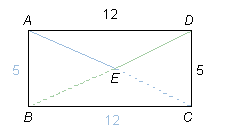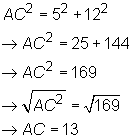Tas: Select the correct answer and then click Continue.

If E is the intersection of two diagonals
of rectangle ABCD, what is the perimeter of
triangle AEB?
In order to find the perimeter of  AEB,
we must find the lengths of AE and ED. We
are told that the endpoint E is also the intersection
of the rectangle's diagonals. Since diagonals of a rectangle bisect
each other, this means that AE must be half the length
of diagonal AC, and DE must be half the length
of diagonal DB. Furthermore, diagonal AE and
diagonal DE must be equal since a rectangle's diagonals
are equal in length.
AEB,
we must find the lengths of AE and ED. We
are told that the endpoint E is also the intersection
of the rectangle's diagonals. Since diagonals of a rectangle bisect
each other, this means that AE must be half the length
of diagonal AC, and DE must be half the length
of diagonal DB. Furthermore, diagonal AE and
diagonal DE must be equal since a rectangle's diagonals
are equal in length.
To find the length of either diagonal, we can use the rectangle's
length and width as given in the diagram to construct a right triangle
with a diagonal as the hypotenuse (see diagram above). We can then
use the Pythagorean theorem to find the length of the diagonal.
Let's use  ADC
to find AC:
ADC
to find AC:

Note that our result is a Pythagorean ratio (5:12:13). We calculated
our result to illustrate the use of the Pythagorean theorem, but
on test day it will be to your advantage to know and use side ratios
to cut down on calculation time.
Since both AE and ED are half the length
of the diagonal, together they equal the full length of the diagonal,
or 13. Added to side AD, we have a total perimeter of
13 + 12 = 25.
Next to display next topic in the chapter.
Test Prep Lessons With Video Lessons and Explained MCQ
Large number of solved practice MCQ with explanations. Video Lessons and 10 Fully explained Grand/Full Tests.